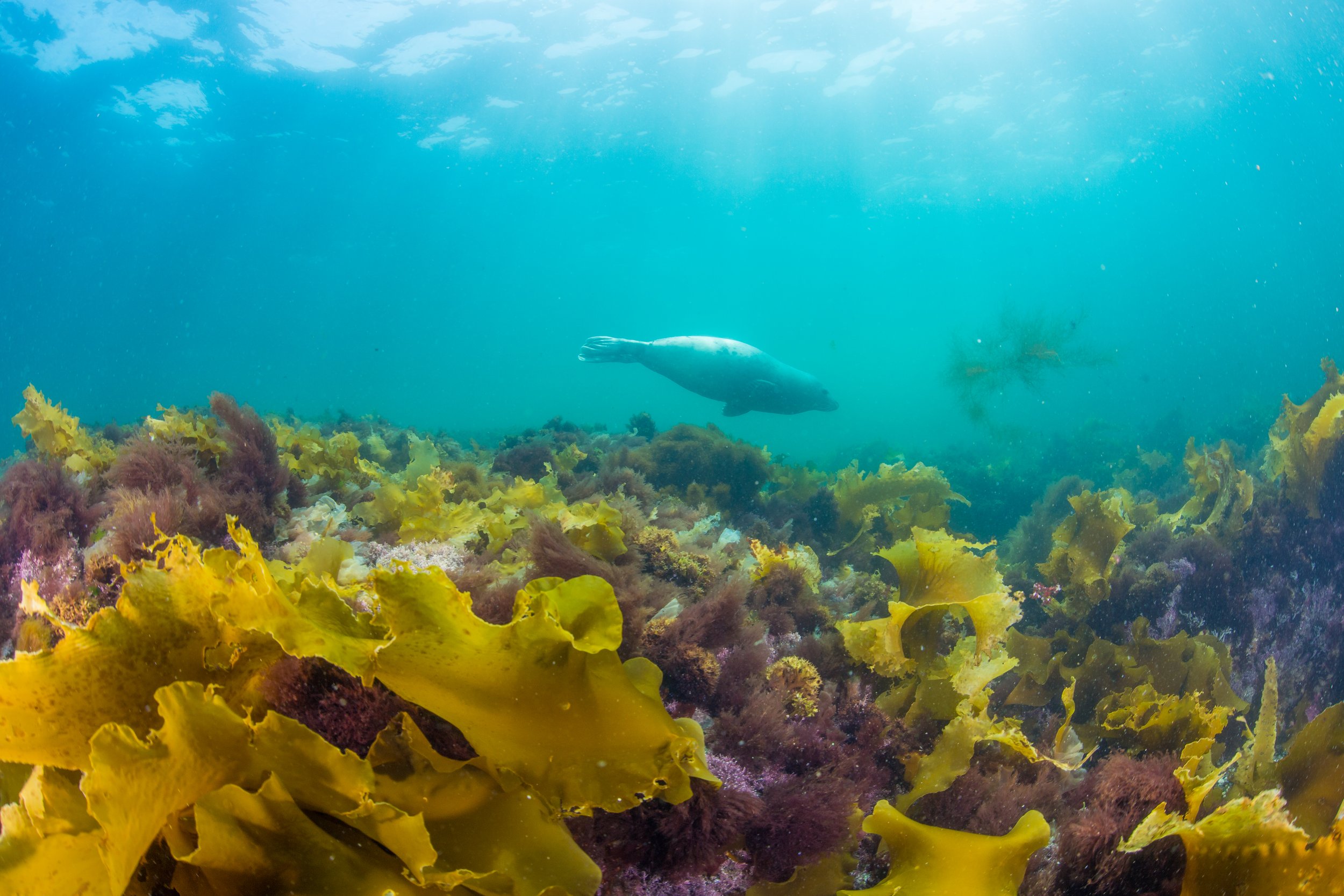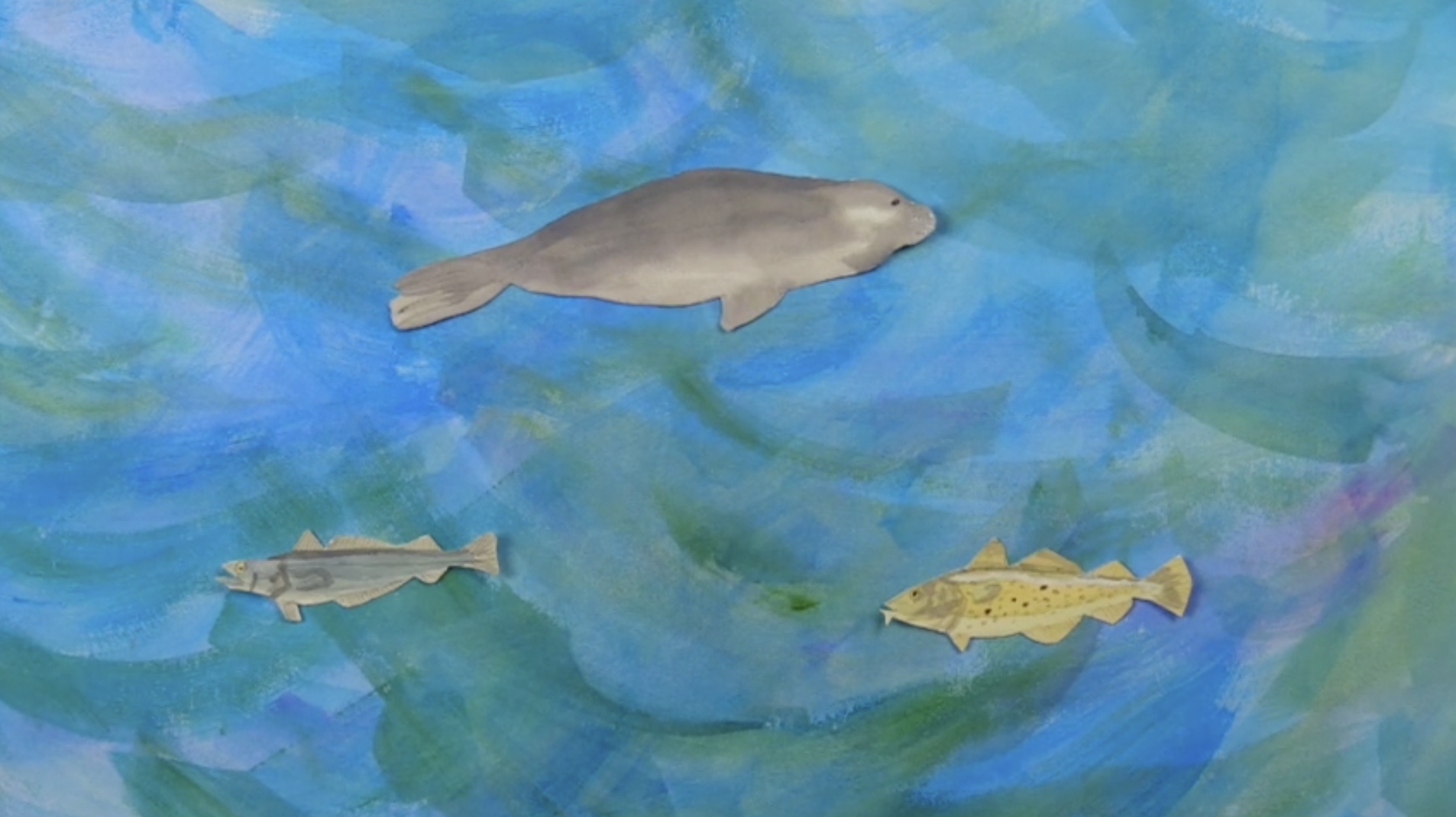
What do Seals Eat?
Everyone — scientists, beach-walkers, fishermen, and boaters — are eager to learn more about seals in the marine food web. What do they eat? How much? Who eats them? What other nuances are in the story of a seal’s diet?
People are both curious in general…. after all, eating is a basic and shared preoccupation with all living beings, And scientists and managers want to know so that we can make sure that the rules and regulations for human activities, like fishing, are supporting a balanced ecosystem. Thinking about what seals eat is an important component for ecosystem based management. This framework recognizes that “individual ecosystem components (biological, physical, chemical, social, cultural, economic) are intrinsically linked to other components within a coupled socio-ecological system.”
“What do seals eat?” might seem like a simple question, but it’s not.
Firstly: seals don’t eat like us (three squares a day). They live a more seasonal life, pulsed by periods of fasting and periods of foraging. During breeding (winter) and molting (spring) seals eat very little, if at all. On the breeding colony, a female gray seal can lose up to 1/3 of her body weight as she gives birth and then nurses, providing her pup with rich, fatty milk (seal milk is about 40% fat).
Then, seals have periods of more intense foraging, to replenish the supplies they’ve lost. How much do they eat then? We don’t have a way to measure that to an exact number. Researchers can identify prey consumed in the wild through several methods and use models to measure activity budgets. The diets of seals in captivity are very different because their energetic budget (and their yearly cycles) are vastly different from seals in the wild. Researchers use a best estimate to understand consumption estimates.
Even though we still have questions about “how much,” researchers have made great strides on the “what.”
What Do Seals Eat?
Seals eat what’s plentiful and nearby. They are generalists. Data show that a large part of their diet in the Gulf of Maine are flatfish, hake, and sand lance, a small, non-commercial fish also eaten by birds, whales, and other fish.
Scientists have studied seal diet through many methods: direct observation (watching them), hard part analysis (looking at what’s in the stomach of dead seals or in poop that live seals leave behind), as well as methods such as fatty acid analysis, stable isotope analysis and by amplifying DNA.
Each method has its strengths and challenges, but by using multiple methods, each has shown the same pattern of general, opportunistic diet.
These tiny, white things are “otoliths,” the ear bones of fish.
Each fish species has a differently shaped otolith, and these bones are hard enough to pass intact through a predator’s digestive tract.
So: by finding the otoliths in seal scat, you can see what a seal’s been eating recently.
Seals and Cod
Some people believe that seals have been a large contributing factor to the decline in the Atlantic cod fishery in Canada and New England.
Science, however, does not show that cod is a big part of gray seal diet today in the northeast US. This may be, partly, because cod populations in the region are much lower than they once were, due to overfishing.
Was cod a large part of a seal’s diet historically? That’s a hard question to answer. The population of seals, cod, and people—as well as other cod predators—has seen huge changes in the past three centuries.
Some research suggests that, while seals may not have caused the decline in cod, they are preventing its recovery due to parasites and predation. It’s true that gray seals are host to “cod worm” (Pseudoterranova decipiens), a parasite that makes fish like cod less palatable to people.
But the story is more nuanced than “seals hurt cod.” In fact, seals may help juvenile cod grow to adults by hunting their predators.
It’s complicated, and studying the dynamic between predator and prey can often reveal surprising stories in the marine food web.
How Seals Help Cod (Animated Video)
References:
Paterson, William D., Simon E. Moss, Ryan Milne, John I. Currie, Dominic J. McCafferty, and Dave Thompson. "Increased metabolic rate of hauled-out harbor seals (Phoca vitulina) during the molt." Physiological and Biochemical Zoology 94, no. 3 (2021): 152-161.
Don Bowen, W., & Jonsen, I. D. (2022). Foraging Ecology and Behavior. In Ethology and Behavioral Ecology of Phocids (pp. 179-227). Cham: Springer International Publishing.
Li, L., Ainsworth, C., & Pitcher, T. (2010). Presence of harbour seals (Phoca vitulina) may increase exploitable fish biomass in the Strait of Georgia. Progress in Oceanography, 87(1-4), 235-241.
Aarts, G., Brasseur, S., Poos, J. J., Schop, J., Kirkwood, R., Van Kooten, T., ... & Tulp, I. (2019). Top‐down pressure on a coastal ecosystem by harbor seals. Ecosphere, 10(1), e02538.
Wenzel, Frederick & Early, Greg & josephson, elizabeth & Greer, William & Lentell, Betty & polloni, pam & Craddock, James & Ampela, Kristen & Peoples, Audy & Waring, Gordon. (2017). What does stomach content analysis tell us about the diet of gray seals (Halichoerus grypus atlantica) incidentally caught in fisheries off the northeast United States?. October 2017, Conference: Society for Marine Mammalogy Conference, Halifax, Nova Scotia, Canada



